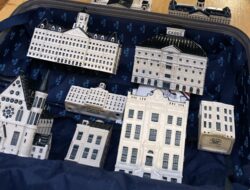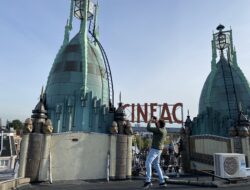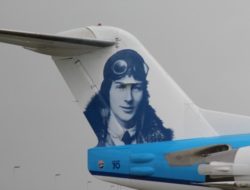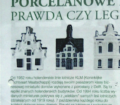Dutch aviation pioneer Anton Herman Gerard Anthony Fokker was born in 1890 in Blitar (then Dutch East Indies, now Indonesia), to Herman Fokker, a Dutch coffee plantation owner. Some sources say that he was born in Kediri. At that time, When Fokker was four, the family returned to the Netherlands and settled in Haarlem in order to provide Fokker and his older sister, Toos, with a Dutch upbringing.
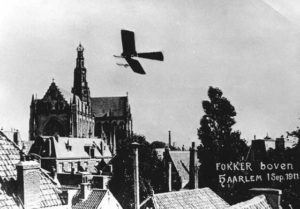
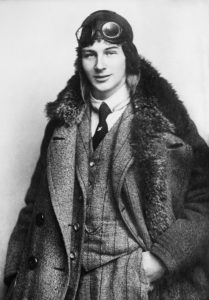
Fokker was not a studious boy and did not complete his high school education but he showed an early interest in mechanics, and preferred making things, playing with model trains and steam engines and experimenting with model aeroplane designs. He devoted considerable effort to the development of a wheel that would not suffer from punctures, basically a wheel with a perimeter formed by a series of metal plates. This idea had been experimented with elsewhere and was already patented.
In 1912, Fokker moved to Johannisthal near Berlin where he founded his first own company, Fokker Aeroplanbau. In the following years he constructed a variety of airplanes. He relocated his factory to Schwerin where it was renamed Fokker Flugzeugwerke GmbH, and later shortened to Fokker Werke GmbH.
Involvement in World War I
At the outbreak of World War I the German government took control of the factory. Fokker remained as director and alleged designer of many aircraft for the Imperial German Army Air Service (Luftstreitkräfte), including the Fokker Eindecker and the Fokker Dr.I, the triplane made famous in the hands of aces such as Manfred von Richthofen (the Red Baron). In all, his company delivered about 700 military planes to the German air force as well as supplying the German navy and Austria-Hungary.
Fokker himself was a skilled pilot, demonstrating his aircraft on many occasions. On 13 June 1915, Fokker demonstrated the new Eindecker (monoplane) at Stenayin the German 5th Army Sector in front of the German Crown Prince and other VIPs. Fokker worked closely with an accomplished military pilot, Otto Parschau, to bring the Eindecker into military use and on this occasion both men demonstrated the aircraft. Max Immelmann, later to become a high-scoring Flying Ace with the Eindecker, commented in a letter written shortly after this event on 25 June 1915 that:”Fokker, especially, amazed us with his skill”.
Author A.R. Weyl says that, while Fokker was a talented and bold pilot, his business character was more flawed. He failed to reinvest war profits back into his factory which consequentially struggled to fulfill war contracts as the factory floor was often muddled with prototype development and production taking place at the same time. Fokker distrusted qualified engineers (which he was not) and resented frequent German insistence on carrying out stringent structural tests to ensure prototype aircraft were fit for combat. He could be bad tempered and insensitive as when he verbally abused his dying designer Martin Kreuzer on the evening of 27 June 1916, after Kreuzer had crashed the prototype Fokker D.I. The rudder jammed but Kreuzer was able to give a verbal report on the accident before he died. “Fokker hurried to the scene and shouted reproaches at the mortally injured man”. Weyl says this incident was witnessed by Reinhold Platz, who succeeded Kreuzer.
While Weyl’s biography paints an unpleasant picture of Fokker as a businessman, he was a popular and charismatic figure with service pilots and could charm even senior officers. This charm enabled him to deal with the first major crisis of his German career when his newly delivered Fokker Dr.I triplanes began to experience sudden fatal accidents in late 1917 and the type was temporarily grounded as too dangerous to fly. The triplanes’ top wings frequently ripped off under aerobatic conditions and even Lothar von Richthofen (brother of Manfred) was lucky to survive one such crash.
Fokker was able to prove to the German high command that the basic design was not at fault but the German military inquiry concluded that shoddy workmanship due to poor supervision and quality control at the Fokker factory were to blame. Fokker received a stern warning about future conduct. Unfortunately the same scenario repeated itself again, a few months later, with the introduction of his E.V/D.VIII monoplane in mid-1918. A further high level German inquiry revealed more production and workmanship issues. Weyl asserts that the German authorities were now willing to file criminal charges against Fokker and might have done so, had he not returned to the Netherlands shortly after the end of World War I.
Fokker’s own account of the D.VIII places the blame on officious German Air Force inspectors requiring an ill-conceived design change. “When the first D-8[sic] was submitted to the engineering division to be sandload tested, the wings proved to be sufficiently strong, but the regulations called for a proportionate strength in the rear spar compared to the front spar… Compyling with the government’s edict, we strengthened the rear spar and started to produce in quantity…” The D.VIII’s immediately ran into trouble with the wing collapsing at high speed. Fokker recalled the aircraft for further testing, and successfully demonstrated that the reinforced rear spar caused the wings to flex unevenly at speed, increasing the angle of attack at the wing tips and causing the wing to shear apart under the increased loads. The problem was resolved by restoring the rear spar to its original specifications.
Weyl also discusses claims of Fokker’s outright plagiarism or taking sole credit for the work of his staff, first designer Martin Kreuzer and later Reinhold Platz. For example, contemporary German documents for the E.V/D.VIII refer to Fokker as ‘the designer’ but Weyl and other authors now suggest that Platz was the real design genius behind the Dr.I, D.VII and D.VIII. There may be some truth in this as Platz recalled to Weyl that he attended high level meetings alongside Fokker but was never introduced or referred-to as the designer and often never even spoke. Yet when Fokker fled Germany it was Platz who immediately took over the German works on Fokker’s behalf. Fokker later moved Platz to the Netherlands, as head designer, when the post-war German operation collapsed which indicates Platz really did play a greater design role than Fokker admits. Weyl uncharitably suggests that Platz’s role at the Fokker D.VIII crisis meetings was to take the blame if anything was wrong and not receive credit. How much of this interpretation is based on the fact that Platz was still alive to tell his side of the story in 1965, and Fokker was not, is unclear.
Another book by Henri Hegener (who knew both Fokker and Platz personally) depicts a rather different story, saying that Platz, while a skilled craftsman (and excellent welder), had received no formal technical training, and that his contributions to the Fokker designs are exaggerated, although Hegener grants that Platz was a good “rule of thumb” designer. Hegener also contradicts the claims that Platz was treated badly by Fokker, at least not financially because Platz’s year-end bonuses often exceeded his yearly salary.
The interrupter gear
Fokker is often credited with having invented the synchronization device which enabled World War I aircraft to fire through the spinning propeller. His role was certainly significant but there were a number of prior developments before the result was achieved for which Fokker is commonly credited.
The famous French pilot Roland Garros was shot down on 18 April 1915. His aircraft had been fitted with a deflector device, whereby metal deflector wedges were fitted to the airscrew. Garros was able to set fire to the airframe before being taken prisoner but the aircraft’s gun and the armoured propeller remained intact and came into German hands.
This initiated a phase of consideration of the interrupter gear concept in the Imperial German Army Air Service. Fokker was heavily involved in this process but the story of his conception, development and installation of a synchronization device in a period of 48 hours (first found in an authorized biography of Fokker written in 1929) has been shown to be not factual. The available evidence points to a synchronisation device having been in development with Fokker’s company for perhaps six months prior to the capture of Garros’ machine. Additionally there were patents filed in France, Germany and Austria-Hungary as far back as 1910 which show a very similar device to that pioneered by Fokker. Author A. J. Weyl suggests that Fokker – or more probably someone on his production team – were aware of these patents. One patentee, Franz Schneider and his employer LVG, later sued Fokker in the German courts and won their case; but Fokker (by now in America) refused to pay up.
However the final result of the development was Fokker’s pushrod control mechanism, Gestängesteuerung, which allowed the aircraft’s forward-firing machine gun to fire only when the propeller was out of the line of fire. As incorporated into the famous Fokker Eindecker, its use directly led to a phase of German air superiority known as the Fokker Scourge. Despite its shock effect on the enemy, the first Fokker interrupters remained unreliable and were prone to failures. Both Oswald Boelcke and Max Immelmann survived failures which resulted in propellers being shot off and even engines pulled out of their mountings due to the engine becoming unbalanced by the loss of the propeller. Immelmann’s eventual death in combat has also been attributed to interrupter gear failure as the aircraft was seen to break up in mid-air while engaged against a Royal Flying Corps.
Other works on aircraft armament
Fokker and his armament team, including Lübbe and Leimberger, also worked on lesser known projects, including a multi-barrelled machine gun, known as the Fokker-Leimberger. Although superficially similar to a Gatling, the action of the Fokker-Leimberger was substantially different. Problems with the gun, especially with ruptured cases, prevented its adoption into production during the war. After moving to the US, Fokker continued to work on the design, but he was ultimately unsuccessful—properly sealing the rotary split-breech was apparently very difficult. A single surviving prototype is known today at the Kentucky Military Treasures.
Return to the Netherlands
After the war’s end, the terms of the Treaty of Versailles forbade Germany to build any aircraft or aircraft engines. The treaty singled out the Fokker D.VII for destruction or confiscation, the only aircraft to be named in the treaty. In 1919 Fokker returned to the Netherlands and started a new aircraft company, the Nederlandse Vliegtuigenfabriek (Dutch Aircraft Factory), predecessor to the Fokker Aircraft Company. Despite the strict disarmament conditions in the Treaty, Fokker did not return home empty-handed: he managed to smuggle six goods trains’ worth of D.VII and C.I military planes and spare parts out of Germany across the German-Dutch border. Author Weyl says that Fokker used 350 railway wagons and made sure that each train was too long to fit into the railway sidings where trains were normally checked for contraband. Weyl quotes Fokker himself as saying that he paid 20,000 Dutch guilders in bribes. The trains included 220 aeroplanes, more than 400 aero engines and much other material. This initial stock enabled him to quickly set up shop, but his focus shifted from military to civil aircraft such as the very successful Fokker F.VII trimotor.
Fokker’s admitted bribery has contributed to his reputation for sharp business practices. Weyl also points out that – in addition to possible criminal charges for the Fokker D.VIII fatal crashes – Fokker also failed to pay taxes to German authorities and actually owed more than 14 million marks. Fokker’s autobiography tells a similar story, but focuses on the rampant corruption, hyper-inflation, economic meltdown, and violent revolutionary forces of the pre-Weimar days. According to Fokker’s account, as WWI progressed, the German High Command became increasingly brazen, even forcing Fokker into German citizenship against his will. Fokker describes his escape from Germany as a harrowing tale in which he protected as many workers as possible and escaped with less than a quarter of his net worth. He takes pains to rebuff the claim that he left the country owing any taxes.
Personal life
On 25 March 1919, Fokker married Sophie Marie Elisabeth von Morgen in Haarlem. This marriage ended in divorce in 1923. In 1927, he married Canadian Violet Eastman in New York City. On 8 February 1929, she died in a fall from their hotel suite window. The original police report said her death was a suicide, but this was later changed to ‘vertigo victim’ at the request of her husband’s staff. On the subject of his marriages, Fokker wrote, “I have always understood airplanes much better than women. I had more love affairs in my life, and they ended just like the first one, really, because I thought there was nothing that could be more important than my airplanes… I have now learned, by bitter experience, that one must give a little too; in love one has to use one’s brain just as much as in business, and perhaps even more”.
Move to the US and death
He was the maker of the Fokker F-VII airplane Josephine Ford (named after the grand daughter of automobile magnate Henry Ford), which Lieutenant Commander Richard E. Byrd and Machinist Floyd Bennett flew over or near the North Pole on 9 May 1926.
In 1931, Fokker sold his American aircraft plants to General Motors, whereupon they became the company’s General Aviation division.
Fokker died at age 49 in New York in 1939 from pneumococcal meningitis, after a three-week-long illness. In 1940, his ashes were brought to Westerveld Cemetery in Driehuis, North Holland, where they were buried in the family grave.

Mark Zegeling
Author Kingdom by the Sea,
A celebration of Dutch cultural heritage and architecture
